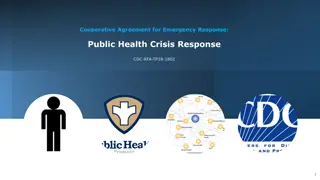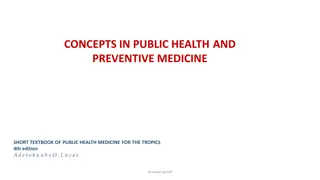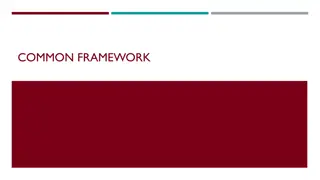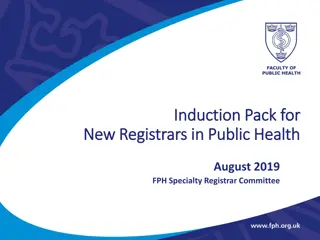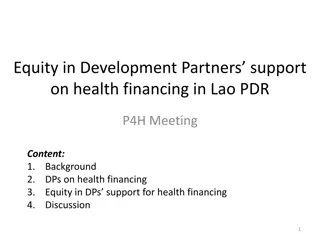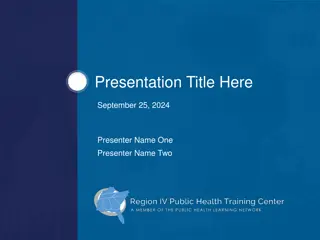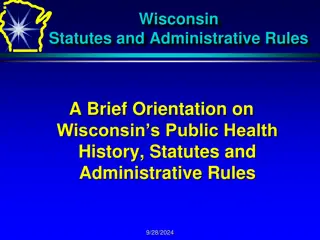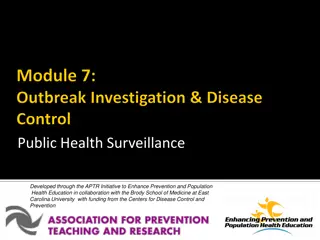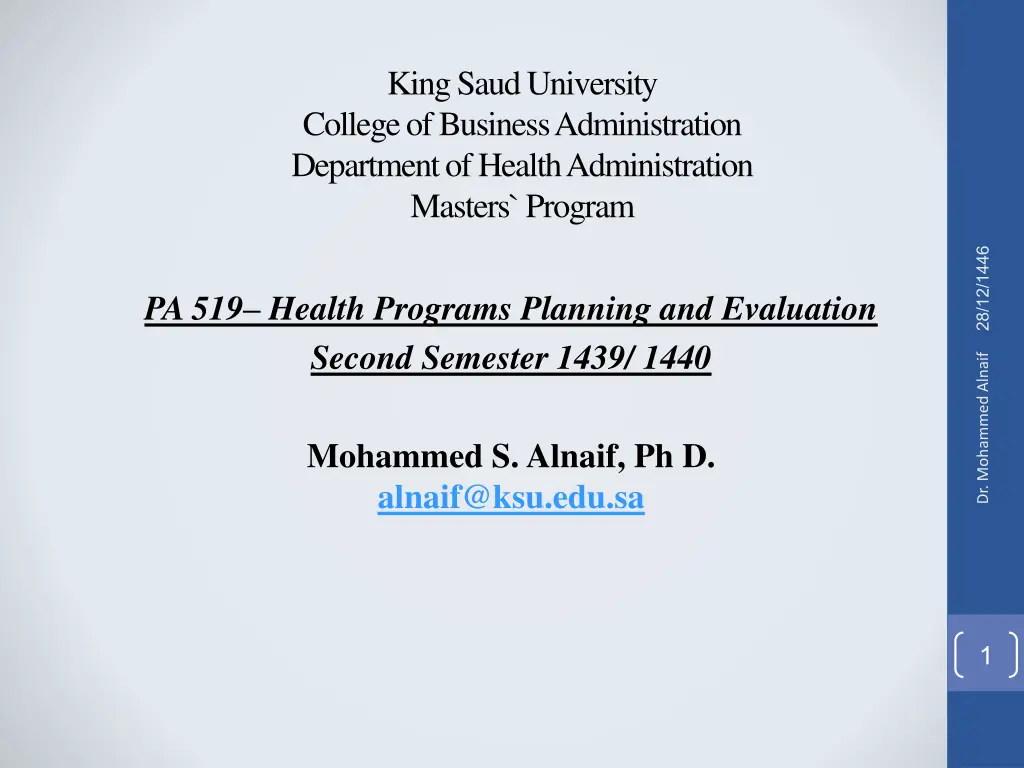
Health Programs Planning and Evaluation in Public Health
Explore the essential aspects of program evaluation in public health, including planning, implementation, and assessment of community needs. Understand the impact of behavior, socioeconomics, and environmental factors on health outcomes. Discover the importance of public health initiatives and the challenges of program evaluation in this dynamic field.
Download Presentation

Please find below an Image/Link to download the presentation.
The content on the website is provided AS IS for your information and personal use only. It may not be sold, licensed, or shared on other websites without obtaining consent from the author. If you encounter any issues during the download, it is possible that the publisher has removed the file from their server.
You are allowed to download the files provided on this website for personal or commercial use, subject to the condition that they are used lawfully. All files are the property of their respective owners.
The content on the website is provided AS IS for your information and personal use only. It may not be sold, licensed, or shared on other websites without obtaining consent from the author.
E N D
Presentation Transcript
King Saud University College of Business Administration Department of Health Administration Masters` Program 28/12/1446 PA 519 Health Programs Planning and Evaluation Second Semester 1439/ 1440 Dr. Mohammed Alnaif Mohammed S. Alnaif, Ph D. alnaif@ksu.edu.sa 1
Health Programs Planning and Evaluation Course Learning Objectives: Students will understand the essential approaches to and components of program evaluation within the context of public health and be able to critically review and conduct evaluations of public health initiatives. Describe the purpose of the public health program, its process from the assessment, design, planning, implementation, and evaluation. Appropriately assess individual and community needs. 28/12/1446 Dr. Mohammed Alnaif 2
Health Programs Planning and Evaluation Course Learning Objectives: 28/12/1446 Use theory-based intervention methods to plan a public health program. Design effective plans for implementation and evaluation of a public health program. Be familiar with the challenges inherent to program evaluation and will be able to describe strategies for navigating these challenges. Identify relationships among the impacts of behavior, socioeconomic status, and culture on health. Explain the impact and control of environmental factors on health. Dr. Mohammed Alnaif 3
Health Programs Planning and Evaluation Public health is all around us. It is the air we breathe, the water we drink, the places we work. Public health is a broad discipline, encompassing professionals from various backgrounds: anthropology, sociology, economics, health behavior, biology, and statistics, to name a few. Perhaps because of its unstructured and extensive nature, public health is not well understood by the public. 28/12/1446 Dr. Mohammed Alnaif 4
Health Programs Planning and Evaluation Although its functions touch our everyday lives, public health is not always identified as the source of the benefits it provides. In the absence of large scale national or global health threats, the public may become complacent about the need for sustaining public health activities, even though it is a field that is always working to improve lives and health. 28/12/1446 Dr. Mohammed Alnaif 5
Health Programs Planning and Evaluation For decades, public health had been eclipsed by novel surgeries and the drama of the emergency room The big problem is that when public health is successful, nothing happens, because we ve prevented it from happening. Stephen Smith, Boston Globe, 1/7/2003 28/12/1446 Dr. Mohammed Alnaif 6
Health Programs Planning and Evaluation Health Defined Health is a state of complete physical, mental and social well being and not merely, the absence of disease or infirmity. World Health Organization 1946 This holistic view of health, incorporating body, mind, and community, is one consistent with the concept of public health, and it will be used as the definition of health in this course. 28/12/1446 Dr. Mohammed Alnaif 7
Health Programs Planning and Evaluation Public Health Defined There are several different definitions of public health, including the following: The science and art of preventing disease, prolonging life and promoting health through organized efforts of society. Faculty of Public Health of the Royal Colleges of Physicians of the United Kingdom. Public Health is the science of protecting and improving the health of communities through education, promotion of healthy lifestyles, and research for disease and injury prevention Association of Schools of Public Health, USA 28/12/1446 Dr. Mohammed Alnaif 8
Health Programs Planning and Evaluation Public Health Defined There are several different definitions of public health, including the following: Public Health is the science and art of preventing disease, prolonging life, and promoting health and efficiency through organized community effort for the sanitation of the environment, the control of communicable infections, the education of the individual in personal hygiene, the organization of medical and nursing services for the early diagnosis and preventive treatment of disease, and for the development of the social machinery to insure everyone a standard of living adequate for the maintenance of health, so organizing these benefits as to enable every citizen to realize his birthright to health and longevity. CEA Winslow 1920, former Chair of Department and Professor of Public Health, Yale University 28/12/1446 Dr. Mohammed Alnaif 9
Health Programs Planning and Evaluation Public health programs aim to prevent or control disease, injury, disability and death. Over time, as this task has become more complex. Increasingly, public health programs address large problems, the solutions to which must engage large numbers of community members and organizations in a vast coalition. More often than not, public health involve significant and difficult changes in attitudes and risk/protective behavior of consumers and/or providers. 28/12/1446 Dr. Mohammed Alnaif 10
Health Programs Planning and Evaluation In addition, the context in which public health programs operate has become more complex. Programs that work well in some settings fail dismally in others because of the fiscal, socioeconomic, demographic, interpersonal, and inter-organizational settings in which they are planted. At the same time that programs have become more complex, the demands for accountability from policymakers and other stakeholders have increased. 28/12/1446 Dr. Mohammed Alnaif 11
Health Programs Planning and Evaluation These changes in the environment in which public health programs operate mean that strong program evaluation is essential now more than ever. There is no one right evaluation. Rather, a host of evaluation questions may arise over the life of a program that might reasonably be asked at any point in time. Addressing these questions about the effectiveness of the program means paying attention to documenting and measuring the implementation of the program and its success in achieving intended outcomes. 28/12/1446 Dr. Mohammed Alnaif 12
Health Programs Planning and Evaluation Planning for the health of populations has progressed, and it is now considered a key characteristic of the discipline of public health. Blum (1981) related planning to efforts undertaken on behalf of the public well-being to achieve deliberate or intended social change as well as providing a sense of direction and alternative modes of proceeding to influence social attitude and actions. The purpose of planning is to ensure that the program has the best possible likelihood of being successful, defined in terms of being effective with the least possible resources. 28/12/1446 Dr. Mohammed Alnaif 13
Health Programs Planning and Evaluation In simple terms the planning entails: defining the problem; working out what to do about it; acting; and evaluating what impact this has had. In the real world of public health however, it is more complex. It requires partnerships between government, communities and organizations, and collaboration across levels of government and between different sectors. The often multiple causes of public health problems need to be understood and judgements made about what can be changed. Judgements also need to be made about what levels of evidence are needed before action can be taken. 28/12/1446 Dr. Mohammed Alnaif 14
Health Programs Planning and Evaluation The common feature of the diverse programs and services labelled public health is the focus on the determinants of health and the systematic management of these determinants. This is the framework s starting point in defining a common approach to planning in public health. 28/12/1446 Dr. Mohammed Alnaif 15
Health Programs Planning and Evaluation Evaluation encourages us to examine the operations of a program, including which activities take place, who conducts the activities, and who is reached as a result. In addition, evaluation will show how faithfully the program adheres to implementation protocols. Through program evaluation, we can determine whether activities are implemented as planned and identify program strengths, weaknesses, and areas for improvement. 28/12/1446 Dr. Mohammed Alnaif 16
Health Programs Planning and Evaluation Program evaluation is a tool with which to demonstrate accountability to an array of stakeholders who may include funding sources, policymakers, regions, and local agencies implementing the program, and community leaders. Depending on the needs of stakeholders, program evaluation findings may demonstrate that the program makes a contribution to reducing morbidity and mortality or relevant risk factors; or that money is being spent appropriately and effectively; or that further funding, increased support, and policy change might lead to even more improved health outcomes. 28/12/1446 Dr. Mohammed Alnaif 17
Health Programs Planning and Evaluation The mission of public health is to [fulfill] society s interest in assuring conditions in which people can be healthy . (Institute of Medicine, 1988) This mission comprises two areas that are vital to an understanding of public health. The first is fulfilling society s interest. As mentioned, public health is very much concerned with the needs and demands of the public. The second part of this mission statement, assuring conditions in which people can be healthy , highlights the supportive role public health plays in the health of the populace. 28/12/1446 Dr. Mohammed Alnaif 18
Health Programs Planning and Evaluation The mission of public health This responsiveness to the will of the public also means public health is a fluid discipline. Although it has core functions and hallmarks, the purview and activities of public health change over time. This aspect of public health is one of the cornerstones of the field, namely that public health embraces a social - ecological model of health. 28/12/1446 Dr. Mohammed Alnaif 19
Health Programs Planning and Evaluation The mission of public health This model essentially holds that health is not a result of individual factors alone but is also a result of external factors, such as those produced by family members, peers, and society as a whole. The social - ecological model will be described in more detail in later lectures. One other cornerstone of public health not directly addressed in this mission statement is the focus on prevention. 28/12/1446 Dr. Mohammed Alnaif 20
Health Programs Planning and Evaluation The mission of public health Public health does not necessarily provide medical care to individuals but rather assures conditions that support health. For example, smoking bans in restaurants and food - labeling requirements are public health efforts to prevent harmful exposures and to provide information to the public in order to promote healthful choices. 28/12/1446 Dr. Mohammed Alnaif 21
Health Programs Planning and Evaluation The mission of public health The substance of public health is organized community efforts aimed at prevention of disease and the promotion of health. The organizational framework of public health encompasses both activities undertaken within the formal structure of government and the associated efforts of private and voluntary organizations and individuals. The core functions of public health are defined as: Assessment, Policy development, Assurance. 28/12/1446 Dr. Mohammed Alnaif 22
Unique Features of Public Health Basis in Social Justice Philosophy Inherently Political in nature Dynamic Ever Expanding Agenda Link with Government Grounding in Science Use of Prevention as a Prime Strategy Uncommon culture and bond 28/12/1446 Dr. Mohammed Alnaif COMPARE TO MEDICAL CARE!!! 23
Unique Features of Public Health Social Justice Philosophy Inherently Grounded in Science Political Nature Expanding Agenda Link with Government Uncommon Culture Focus on Prevention
Health Programs Planning and Evaluation What is Social Justice? Justice indicates fairness in the distribution of benefits and burdens in society. Access to health services, or even good health itself is considered a social benefit and conversely, poor health is considered a burden. There are significant factors within society that impede the fair distribution of benefits and services (e.g. social class, heredity, racism) 28/12/1446 Dr. Mohammed Alnaif 25
Health Programs Planning and Evaluation What is Social Justice? Many modern public health problems disproportionately affect some groups (Poor Public Education Systems Poverty). Collective actions are then necessary This means that those less affected take on greater burdens while not directly benefiting from those actions. 28/12/1446 Dr. Mohammed Alnaif 26
Health Programs Planning and Evaluation Inherently Political Nature The social justice underpinnings of Public Health serve to stimulate political conflict. Political conflict allows for issues to be considered, negotiated, and finally determined for population. Unique features, values, purposes, aims and models of Public Health. At the core of political processes are values, purposes, aims and models of Public Health. 28/12/1446 Dr. Mohammed Alnaif 27
Health Programs Planning and Evaluation Dynamic Ever Expanding Agenda In the middle of twentieth century, Chronic disease prevention and medical care fell into Public Health s realm as an epidemiologic revolution began to identify causative gents of chronic diseases and links between use of health services and health outcomes. Later, Substance abuse, mental illness, teen pregnancy, long-term care, and other issues fell to Public Health, as did several emerging problems, most notably the epidemics of violence and HIV Infection, including AIDS. 28/12/1446 Dr. Mohammed Alnaif 28
Health Programs Planning and Evaluation Link with Government Only Government can exercise the enforcement provisions of our public policies that limit the personal and property rights of individuals and corporations in areas such as retail of food establishment, sewage and water system, occupational health and consumer product safety. Government can modify public policies that influence health through social, environmental conditions such as policies for education, employment, housing, public safety, child welfare, pollution control, workplace safety and family support. 28/12/1446 Dr. Mohammed Alnaif 29
Health Programs Planning and Evaluation Grounding in sciences The old image of Public Health based on hard sciences underlying environmental sanitation and communicable disease control is superseded by a new image of Public Health approaches more grounded in what the public perceives to be softer science. The quantitative sciences of Epidemiology and Biostatistics remains essential tools of Public Health practice. In recent decades knowledge from social sciences has greatly enriched and supplemented the physical and biological sciences. 28/12/1446 Dr. Mohammed Alnaif 30
Health Programs Planning and Evaluation Use of Prevention as a Prime Strategy In generally prevention characterizes actions that are taken to reduce the possibility that something will happen or in hope of minimizing the damage that may occur if it does happen. Although prevention is considered by many to be the purpose of public health, the specific intentions of prevention can vary greatly. Because of unseen consequences, people are less likely to develop an attachment for or support the efforts preventing them. Despite its lack of recognition, prevention as a strategy has been remarkably successful and appears to offer great potential for future success. 28/12/1446 Dr. Mohammed Alnaif 31
Health Programs Planning and Evaluation Uncommon Culture Public health is multidisciplinary- interdisciplinary and utilizes a population-level focus. The link between people working in Public Health is NOT a specific professional degree or work setting Public Health professionals are connected by the intended outcomes of their work.. Promoting, protecting, and preserving the public s health. 28/12/1446 Dr. Mohammed Alnaif 32
A Sampling of Public Health Professions Alcohol, tobacco and other drugs Chiropractic health care Community health planning and policy development Environment Epidemiology Food and nutrition Gerontological health Health administration HIV AIDS Injury Control and Emergency Health Services International Health Maternal and Child Health Medical Care Mental Health Occupational Health and Safety Oral Health Podiatric Health Population, Family Planning & Reproductive Health Public Health Education and Health Promotion Public Health Nursing School Health Education and Services Social Work
Health Programs Planning and Evaluation Public Health vs. Medical Care One way to better understand public health and its functions is to compare it to medical practice. While medicine is concerned with individual patients, public health regards the community as its patient trying to improve the health of that population. Medicine focuses on healing patients who are ill. Public health focuses on preventing illness. 28/12/1446 Dr. Mohammed Alnaif 34
Health Programs Planning and Evaluation Public Health vs. Medical Care 28/12/1446 Dr. Mohammed Alnaif 35
Health Programs Planning and Evaluation Modern Public Health Public health, and its tenets and activities, has evolved throughout time in response to shifts in societies values and scientific knowledge. Some of the historical issues of infectious diseases, health disparities, and population assessment continue to be modern public health challenges. There are new public health challenges also: populations are more mobile than ever, heightening concerns about pandemics. When an epidemic escapes its local region and starts to affect people over a large portion of country or even the world, it said to be pandemic. 28/12/1446 Dr. Mohammed Alnaif 36
Health Programs Planning and Evaluation Modern Public Health The mortality of many vaccines - preventable diseases declined so dramatically over the course of the twentieth century that often there is complacency about these diseases, and immunization rates have dropped. Antibiotic resistance has also made the apparent victory over common infections less certain. Medical care and insurance continues to cost more than many people can afford. . Bioterrorism and natural disasters have required planning for mass immunization, prophylaxis, evacuation, and treatment. 28/12/1446 Dr. Mohammed Alnaif 37
Health Programs Planning and Evaluation Hallmarks of Public Health Although the issues facing public health may vary over time, the underlying principles of public health remain constant. There are three hallmarks of public health that define the field and also provide a contrast to the related field of medicine. Public health and medicine often have the similar goals of reducing the impact of disease and improving health and quality of life, but there are some notable differences between the two in the methods of reaching these goals. The hallmarks of public health are a philosophy of social justice, a focus on populations, and a focus on prevention. 28/12/1446 Dr. Mohammed Alnaif 38
Health Programs Planning and Evaluation Philosophy of Social Justice The term social justice has been used by various groups in different contexts. In public health, the concept of social justice connotes the idea that all individuals in a population should have access to the same programs and services, regardless of social condition or standing. This is in contrast to a concept of access to goods, services, and programs based on market forces, a concept known as market justice. Public health seeks to provide a basic level of health provisions, such as clean food and water, safe neighborhoods, and access to health care services, to all members of a community or population. In this vein, public health works to ensure there are no health disparities. 28/12/1446 Dr. Mohammed Alnaif 39
Health Programs Planning and Evaluation Focus on Populations In medicine, patients typically are seen and managed individually. In public health, the focus is on groups of people or populations rather than on individuals. Public health endeavors to implement programs that benefit a group of people: water fluoridation, folic acid fortification of grain products, the development of safe walking trails throughout a city, etc. Ultimately, these public health interventions will impact individuals health, but the needs, desires, and attributes of the population as a unit are considered when making decisions in public health, rather than what will benefit each individual person. 28/12/1446 Dr. Mohammed Alnaif 40
Health Programs Planning and Evaluation Focus on Prevention Public health focuses on prevention and the numerous efforts to prevent people from being exposed to harmful or unhealthful substances or experiences. Indeed, public health focuses on preventing poor health outcomes or exposures that lead to these outcomes, and this focus is a hallmark of the field. Prevention has multiple levels, some of which may surprise you. Public health seeks to identify risk factors for disease and then works to learn methods for eliminating or limiting these risk factors to prevent populations from becoming ill or experiencing poor health. In addition, public health typically aims to maintain health rather than to address decrements in health after they have occurred. 28/12/1446 Dr. Mohammed Alnaif 41
Health Programs Planning and Evaluation Core Public Health Disciplines Although public health is a multidisciplinary field comprising individuals who may not have formal training in the subject, there are five core disciplines within public health in which practitioners are trained: epidemiology, biostatistics, social and behavioral sciences, environmental health, and health management and policy (Figure 1.2). 28/12/1446 Dr. Mohammed Alnaif 42
(Figure 1.2) Core Public Health Disciplines Epidemiology 28/12/1446 Dr. Mohammed Alnaif Health Management and Policy Biostatistics Public Health Social and Behavioral Sciences Environment al Health 43
Health Programs Planning and Evaluation Core Public Health Disciplines Epidemiology is the study of the determinants and distribution of health outcomes. It encompasses describing health outcomes based on the frequency or number of events and analyzing health outcomes to identify risk factors. Epidemiology may be divided into the two broad areas of chronic disease and infectious disease epidemiology. Biostatistics provides the tools to understand public health data. It is a branch of statistics devoted to understanding health and health outcomes and allows the analysis of complex studies. 28/12/1446 Dr. Mohammed Alnaif 44
Health Programs Planning and Evaluation Core Public Health Disciplines Environmental health is largely concerned with the impact of various exposures on health. Environment is broadly defined and may include any aspect of the physical environment and its relationship to health outcomes. Social and behavioral sciences focus on individual - level factors and the impact of external factors on health, primarily the influence of the social environment. This discipline includes understanding how people respond to external messages and information and how to change behavior. Health management and policy is the discipline most concerned with issues of health care access and the policies at various levels of an organization or government, as well as how these policies impact health outcomes. 28/12/1446 Dr. Mohammed Alnaif 45
Health Programs Planning and Evaluation Core Public Health Disciplines Modern public health training programs typically include each of these disciplines in their master s of public health (MPH) degree program. Although each discipline has specialty skills and techniques for conducting its part of public health research and practice, public health education also includes cross - disciplinary training. This cross - training allows professionals in different disciplines to work together to solve problems that benefit from the application of more than one set of skills. For more information about how public health training programs are organized and the competencies of these disciplines, visit the Council on Education in Public Health Web site, http://CEPH.org/. 28/12/1446 Dr. Mohammed Alnaif 46
Health Programs Planning and Evaluation Public Health Ethics Ethical dilemmas abound in public health as we weigh the benefit to the group against the freedoms of the individual. For example, should we compel someone with an infectious disease to take medication or to remain in isolation to prevent others from becoming ill? If we know a behavior greatly increases the risk of morbidity or mortality, should laws be enacted to prevent it? If we are trying to understand the risks associated with an activity, but we do not want study participants to change their activity patterns during the course of study, are we obligated to disclose the purpose of the study? 28/12/1446 Dr. Mohammed Alnaif 47
Health Programs Planning and Evaluation Public Health Ethics Some ethical concerns in public health seem relatively straightforward. For example, few would believe it ethical to randomly assign study participants to an exposure with even moderate evidence of harm, such as radiation, for the sake of research alone. Nonetheless, there are historical examples of studies that proceeded with agency or even government approval and funding that, in retrospect, were clearly unethical. As a result of past research transgressions, there are guidelines and systems in place to ensure that anyone participating in a research study understands the risks and benefits associated with the study and that the subject consents to be involved in the study, without being bribed or coerced into doing so. 28/12/1446 Dr. Mohammed Alnaif 48
Health Programs Planning and Evaluation Public Health Ethics The Nuremberg Code outlines these and other assurances that must be in place in order to conduct human subjects research. The code arose from the Nuremberg trials of 1946 1947 in which German physicians and their associates were tried, and many convicted, for killing or disabling thousands of people in Nazi concentration camps during World War II. The Belmont Report was created by the National Commission for the Protection of Human Subjects of Biomedical and Behavioral Research in 1976 with the intent of providing an analytical framework that will guide the resolution of ethical problems arising from research involving human subjects . The Belmont Report builds upon the Nuremberg Code, distinguishing between research and practice, outlining three basic ethical principles (respect for persons, beneficence, and justice), and listing specific requirements needed to meet the ethical principles (informed consent, assessment of risks and benefits, and fair selection of subjects) 28/12/1446 Dr. Mohammed Alnaif 49
Health Programs Planning and Evaluation Public Health Ethics At universities and other research organizations, an institutional review board (IRB) or independent ethics committee (IEC) is in place to review all research protocols before they begin. The purpose of the IRB/IEC is to protect human subjects, the individuals who will be involved in the research study. The IRB/IEC typically is made up of researchers and regulatory experts who understand the laws relating to human subject research. The IRB/IEC ensures that potential study participants are given a complete and honest assessment of the activities involved in research and any potential positive and negative outcomes. 28/12/1446 Dr. Mohammed Alnaif 50






